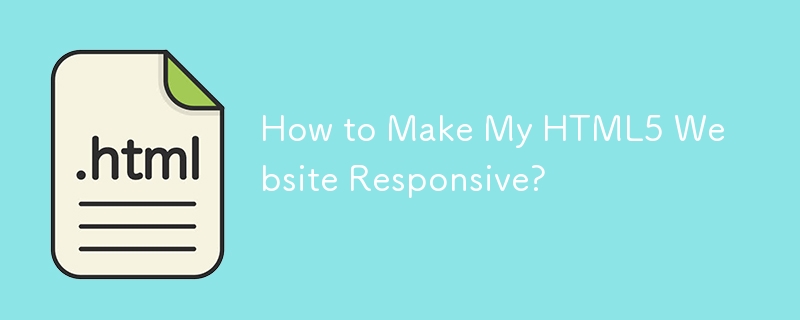Found a total of 10000 related content

How to Make My HTML5 Website Responsive?
Article Introduction:This article details creating responsive HTML5 websites. It emphasizes using viewport meta tags, flexible layouts (with relative units), CSS media queries, and responsive images. Various CSS frameworks (Bootstrap, Tailwind CSS, etc.) and testing me
2025-03-10
comment 0
431

Applying HTML5 Principles to Responsive Web Design
Article Introduction:HTML5 improves responsive design through semantic tags, viewport control, responsive pictures and form optimization. 1. Use semantic tags such as, etc. to improve structural clarity, making it easier to flexibly arrange content blocks according to different devices; 2. By controlling mobile display, ensure that the page is correctly scaled and improve the mobile experience; 3. Use responsive image loading with tags, load adaptive resources according to screen size, and improve performance; 4. Use HTML5 form types such as email and tel to optimize mobile input, trigger the corresponding keyboard to improve user experience.
2025-07-15
comment 0
191

How to make a responsive image gallery with HTML5?
Article Introduction:To create a responsive picture gallery, the core is to use HTML5 and CSS to achieve adaptation of structure and layout. 1. Use and semantic organization of image content; 2. Use CSSGrid or Flexbox for responsive layout, and Grid is recommended to automatically adjust the multi-column arrangement of the number of columns; 3. Set the image width 100%, adapt highly and use object-fit to maintain proportional filling; 4. Pay attention to details such as gap, minmax and alt attributes to improve aesthetics and accessibility.
2025-07-09
comment 0
667

Implementing Responsive Images with the HTML5 Picture Element
Article Introduction:Elements are container elements introduced by HTML5 for implementing responsive pictures, which select the most suitable image resource according to device characteristics through multiple and one tag. 1. It supports loading adaptive pictures according to different screen widths to improve loading performance; 2. It can provide priority to modern formats such as WebP, which will fall back to traditional formats if not supported; 3. It can switch different compositions according to the aspect ratio of the device to optimize visual display; in addition, it is always necessary to add descriptive alt text, ensure correct paths, test compatibility and standardized naming to improve maintainability.
2025-07-14
comment 0
511

How to use the HTML5 picture element for responsive images
Article Introduction:The core of using HTML5's picture elements to implement responsive pictures is to load the most suitable image resources according to the device characteristics. The specific methods are as follows: 1. The elements contain multiple and one, and the browser matches the conditions in order that meets the conditions, otherwise it will fall back; 2. Combining the srcset and sizes attributes, let the browser automatically choose the best size; 3. Prioritize loading of modern formats (such as WebP) by specifying the type attribute, and downgrade supporting traditional formats; 4. Pay attention to order, retain as fallback, consider compatibility and SEO optimization.
2025-07-05
comment 0
872

Using HTML5 Source Set for Responsive Images (srcset)
Article Introduction:How to implement responsive image loading on different devices? Use HTML5's srcset and sizes properties. The specific methods are: 1. Prepare pictures of multiple sizes and mark the width with w units; 2. Define the viewport ratio of pictures under different screen widths in sizes, such as (max-width: 600px)100vw; 3. Pay attention to setting DPR high-definition adaptation, such as 1x/2x descriptor; 4. Always keep src as a compatibility solution; 5. Plan the image size according to the device breakpoint, such as 480px/768px/1024px, etc.; 6. Test the loading effect of each size through the developer tool. This ensures that the browser accurately selects the best picture, taking into account loading speed and display quality.
2025-07-05
comment 0
435

How to make a responsive website with HTML5 and CSS3?
Article Introduction:The key to making a responsive website lies in the reasonable cooperation between HTML5 and CSS3, and the core is to make web pages display well on different devices. 1. Use HTML5 semantic tags to build clear structures, such as, , etc., to make the code easier to read and facilitate search engine crawling; 2. Use CSS3 media query to achieve multi-device adaptation, and apply different rules by detecting screen width, such as setting breakpoints such as mobile phones and tablets; 3. Use elastic layout (Flexbox or Grid) to deal with alignment and arrangement issues, and ensure that the navigation bar and other content automatically adapt to the screen; 4. Set image adaptation, use max-width:100% and srcset attributes to ensure that the image does not destroy the layout and improve the loading effect. Mastering these four key points can achieve compatibility with multiple settings
2025-07-13
comment 0
485

How to Use Bannersnack to Generate Amazing Banners in Seconds
Article Introduction:Bannersnack: Design Stunning Responsive Banner Ads Without Coding
(This article is a sponsored collaboration with StudioWorks. Thank you for supporting our partners.)
Banner ads remain a cornerstone of online advertising, despite their long history
2025-02-15
comment 0
716

What are the best practices for HTML5 development?
Article Introduction:The article outlines best practices for HTML5 development, focusing on semantic HTML, responsive design, accessibility, and performance optimization. It also lists productivity tools and resources for staying updated with HTML5 standards.
2025-03-17
comment 0
1011

Using Device Orientation in HTML5
Article Introduction:HTML5 Device Orientation API: A Comprehensive Guide
This article explores the HTML5 Device Orientation API, a powerful tool for creating responsive web applications that react to a device's physical orientation. We'll cover its functionality, implem
2025-02-21
comment 0
883

Convert the below data into Tabular format in HTML5?
Article Introduction:Here is the converted data into a tabular format using HTML5, including examples and strategies for responsive design, best practices for styling, and semantic HTML5 tags used within a table structure:<!DOCTYPE html>
<html lang=&
2025-04-30
comment 0
913

How do I optimize HTML5 code for performance and accessibility?
Article Introduction:The article discusses optimizing HTML5 for performance and accessibility, focusing on code minimization, semantic elements, caching, and responsive design. Key tools for performance testing and accessibility practices are also covered.
2025-03-17
comment 0
969

How to Embed Images and Videos in HTML5?
Article Introduction:This article details embedding images (<img>) and videos (<video>) in HTML5. It covers tag attributes, responsive design using CSS, and optimization techniques for faster loading, including image/video compression, lazy
2025-03-10
comment 0
356

How Do I Style My HTML5 Website with CSS?
Article Introduction:This article explains HTML5 website styling using CSS. It covers linking CSS, writing styles, using selectors, and best practices for clean structure (e.g., preprocessors, naming conventions). Responsive design techniques like media queries and flu
2025-03-10
comment 0
339

How to Create a Drop-Down Nav Menu With HTML5, CSS3, and JQuery
Article Introduction:This tutorial demonstrates building a responsive dropdown navigation menu using HTML5, CSS3, and jQuery. We'll cover the HTML structure, CSS styling, and jQuery functionality to create a smooth and user-friendly experience.
Project Setup:
Create a
2025-03-04
comment 0
1186

An Introduction to the Genesis Framework
Article Introduction:Genesis Framework: A Deep Dive into WordPress Theme Excellence
The Genesis Framework, a highly regarded WordPress theme structure, stands out for its clean HTML5 and CSS3 coding, resulting in a lightweight, responsive, and SEO-friendly platform. Thi
2025-02-18
comment 0
837

Using Bootstrap 5 with HTML5
Article Introduction:Using Bootstrap5 with HTML5 for front-end development is very direct and efficient. 1. Introducing Bootstrap5 can be achieved through CDN, local files or construction tools. It is recommended that beginners use CDN; 2. Combining HTML5 semantic tags such as , , etc. to improve structural clarity and SEO-friendliness, and paired with Bootstrap's layout classes to achieve responsive design; 3. Using Bootstrap5 components such as modal boxes, navigation bars, etc. to enhance interactive functions, pay attention to ensuring that JS files are correctly introduced and initialized. Once you master these core points, you can quickly build modern and responsive web projects.
2025-07-15
comment 0
748

Is H5 a Shorthand for HTML5? Exploring the Details
Article Introduction:H5 is not just the abbreviation of HTML5, it represents a wider modern web development technology ecosystem: 1. H5 includes HTML5, CSS3, JavaScript and related APIs and technologies; 2. It provides a richer, interactive and smooth user experience, and can run seamlessly on multiple devices; 3. Using the H5 technology stack, you can create responsive web pages and complex interactive functions.
2025-04-14
comment 0
1098

















